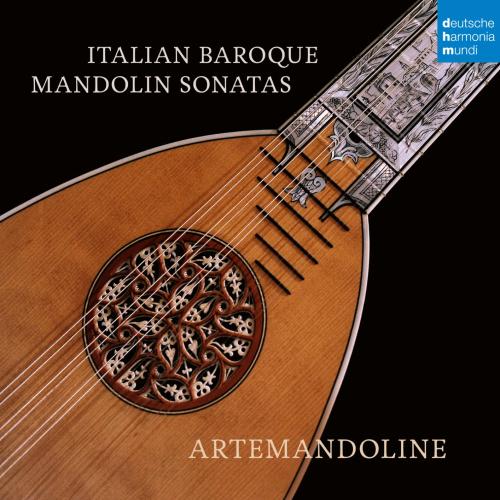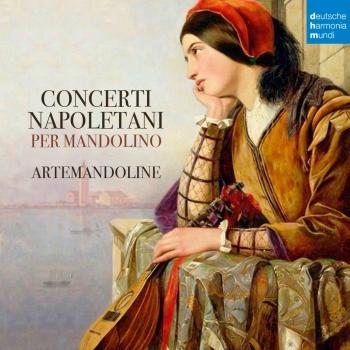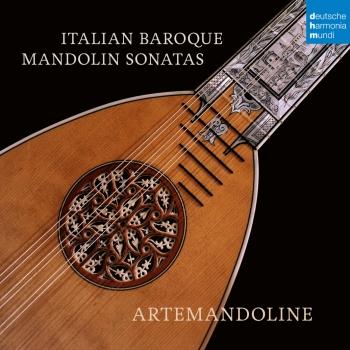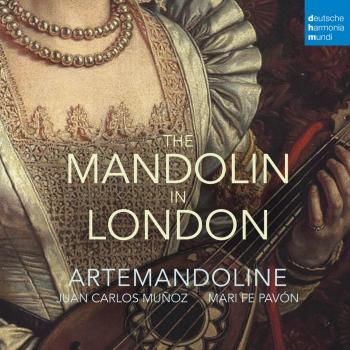
Italian Baroque Mandolin Sonatas ArteMandoline
Album info
Album-Release:
2021
HRA-Release:
12.02.2021
Label: deutsche harmonia mundi
Genre: Classical
Subgenre: Chamber Music
Artist: ArteMandoline
Composer: Abate Ranieri Capponi (1680-1744), Niccolo Susier (1679-1766), Nicola Romaldi (1680-1740), Francesco Piccone (1685-1745)
Album including Album cover Booklet (PDF)
I`m sorry!
Dear HIGHRESAUDIO Visitor,
due to territorial constraints and also different releases dates in each country you currently can`t purchase this album. We are updating our release dates twice a week. So, please feel free to check from time-to-time, if the album is available for your country.
We suggest, that you bookmark the album and use our Short List function.
Thank you for your understanding and patience.
Yours sincerely, HIGHRESAUDIO
- Abbate Ranieri Capponi (1680 - 1744): 12 Sonate da camera, No. 12 in G Major:
- 1 12 Sonate da camera, No. 12 in G Major: I. Largo 02:08
- 2 12 Sonate da camera, No. 12 in G Major: II. Allegro nobile 02:59
- 3 12 Sonate da camera, No. 12 in G Major: III. Fuga 02:05
- 4 12 Sonate da camera, No. 12 in G Major: IV. Scherzo pastorale - Allegro moderato 04:13
- Niccolo Susier (1679 - 1766): Sonata per mandola:
- 5 Sonata per mandola: I. Adagio 01:15
- 6 Sonata per mandola: II. Allegro 01:33
- 7 Sonata per mandola: III. Gavotta 02:16
- 8 Sonata per mandola: IV. Giga 02:17
- Nicola Romaldi (1680 - 1730): Sonata per mandola:
- 9 Sonata per mandola: I. Adagio 02:41
- 10 Sonata per mandola: II. Allegro 02:47
- 11 Sonata per mandola: III. Largo 01:12
- 12 Sonata per mandola: IV. Allegro 01:31
- Abbate Ranieri Capponi: 12 Sonate da camera, No. 8 in E Minor:
- 13 12 Sonate da camera, No. 8 in E Minor: I. Largo 02:58
- 14 12 Sonate da camera, No. 8 in E Minor: II. Allegro assai 02:00
- 15 12 Sonate da camera, No. 8 in E Minor: III. Affettuoso 04:01
- 16 12 Sonate da camera, No. 8 in E Minor: IV. Allegro assai 02:02
- Giovanni Pietro Sesto da Trento: Sonata di mandolino:
- 17 Sonata di mandolino: I. Larghetto 01:52
- 18 Sonata di mandolino: II. Allegro 02:29
- 19 Sonata di mandolino: III. Larghetto 04:53
- 20 Sonata di mandolino: IV. Allegro 02:00
- Francesco Piccone (1685 - 1745): Sinfonia per la mandola in D Minor:
- 21 Sinfonia per la mandola in D Minor: I. Allegro 01:57
- 22 Sinfonia per la mandola in D Minor: II. Largo 01:53
- 23 Sinfonia per la mandola in D Minor: III. Giga 00:55
- 24 Sinfonia per la mandola in D Minor: IV. Minuetto 01:27
Info for Italian Baroque Mandolin Sonatas
Weltersteinspielungen vergessener Meisterwerke des 18. Jahrhunderts für Mandoline und B.c.
Für ihre beiden bisher erschienenen dhm-Aufnahmen mit der Sopranistin Nuria Rial erhielt das Barockensemble Artemandoline unter der Leitung von Juan Carlos Munoz fantastische Besprechungen: »Die Einspielungen bezaubern mit ihrem Einfallsreichtum, Raffinement und vor allem mit ihren einnehmenden Melodien – und einem inspiriert und mitreißend agierenden Orchester.« (Toccata)
Für ihr neues instrumentales Album haben die Musiker echte Entdeckungen italienischer barocker Kompositionskunst ausgegraben: Das Ensemble präsentiert Weltersteinspielungen vergessener Meisterwerke, die in Florenz und Rom des 18. Jahrhunderts für Mandoline und Basso continuo geschrieben wurden. Gefunden wurden diese Raritäten in Notenbibliotheken u. a. in Washington, Mailand aber auch in Deutschland, in Münster. Die Werke stammen von den Florentiner Komponisten Ranieri Capponi (1680–1744) und Niccolò Susier (1679–1766), den in Rom wirkenden Komponisten Nicola Romaldi (1680–1740) und Francesco Piccone (1685–1745) sowie dem norditalienischen Komponisten Giovanni Pietro Sesto da Trento (18. Jh.). Alle Werke besitzen ungemeine Ausdruckstiefe und melodiösen Charme – Musik voller Energie, Schönheit und Virtuosität.
Artemandoline
Juan Carlos Munoz, künstlerischer Leiter
Artemandoline
With their ensemble Artemandoline, formed in 2001, Juan Carlos Muñoz and Mari Fe Pavón chose to go back to the original documents in order to the establish the true pedigree of this incomparable family of instruments. They have made a major contribution to launching a movement to encourage musical freshness and rigour. A better understanding of the compositions, closer study of the early treatises, the playing styles, the musical environment of the glorious era of the mandolin, leads to better appreciation of Baroque music, which itself became over time a mode of thought and action.
Searching for early mandolins, working on the manuscripts, hunting down early treatises, exploring the iconography: these are the means by which, for more than ten years now, the musicians of Artemandoline have sought to do fuller justice to the works of Scarlatti, Vivaldi, Weiss, and their contemporaries. The success of this approach based on a return to the sources, which constitutes the most important development in the history of the interpretation of ‘serious’ music in the course of the twentieth century, has been made possible by the cooperation of many protagonists – musicians, but also concert organisers, recording producers, publishers, musicologists, and instrument makers.
To ensure that music composed in the past does not sound like mere ‘early music’ in the present, the performers must manage to be sufficiently free, spontaneous, anticipative and astonished in their intimate act of creation and the newness it engenders. Juan Carlos Muñoz and Mari Fe Pavón spend their lives searching out and reviving forgotten masterpieces of the mandolin repertory. They are not content with simply presenting their finds like ‘musical archaeologists’, but endeavour to transmit them to the wider public by means of the essential act of communication between interpreters, composers, and listeners.
Very quickly awarded prizes by the critics and enthusiastically acclaimed by the public, Artemandoline’s performances always create new impulsions in the development of both the perception and the interpretation of the works of the seventeenth and eighteenth centuries. Its musicians dedicate their time and their talents to the revival of the mandolin on the musical scene, participating in the current expansion of interest in it all over the world through their conservatory teaching and masterclasses, their concerts, and their publications. Artemandoline is one of the pioneers in this domain, in which it has forged an international reputation.
In a few short years, the ensemble has found its style, proved its instrumental quality, and thereby constituted a veritable identity. Soon after its formation, it took its place among the foremost ensembles in the realm of historical performance practice on plucked strings. Audiences and critics alike were immediately filled with enthusiasm for its lively musical style.
The musicians who make up the ensemble play on period instruments: Baroque mandolins, Renaissance and Baroque guitar, Baroque mandola and mandolone, Renaissance lute, treble lutes, mandolins from Brescia and Cremona.
They are regularly invited to appear at early music festivals in France and abroad, including the Festival de Musique Ancienne du Marais, Festival du Périgord Vert, the « Tage Alter Musik Regensburg » in Germany ; « Early Music Day Alden-Biesen (Belgique) », Musique en Catalogne romane, Festival de l’Épine in France; Monza e Brianza, Gaudete Early Festival (Piedmont), and Castello Reale di Sarre (Aosta), all in Italy; Narol and Wroclaw in Poland; the Baroque Days at the Philharmonie in Luxembourg;; the Bach Chamber Days in Riga (Latvia); Festival Musique d’Ensemble à Pommiers, Oissery, Sedan, and other engagements in Spain, Japan, Switzerland, and Algeria.
The ensemble Artemandoline is in residence at the Romanesque church of Mont St Martin (Longwy, Meurthe-et-Moselle, France).
Booklet for Italian Baroque Mandolin Sonatas












